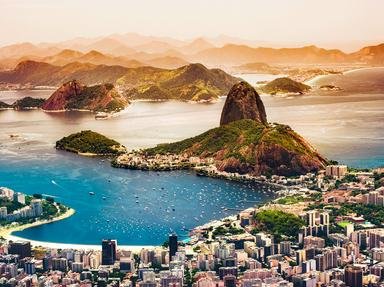Quiz Answer Key and Fun Facts
1. In the north of Brazil, you will find the Ireng River amidst the rolling hills and valleys of the Pakaraima Mountains. The deep dark waters of the Ireng River form much of the border between Brazil and what northern neighbor?
2. About 200 km from the city of Sao Paulo is the Ilhabela Archipelago, including the largest island of Sao Sebastião. The island was named by the first European to visit in 1502. Who was the Italian explorer sailing for Portugal that was himself immortalized as the namesake for two continents?
3. Located in the Tijuca Forest on top of Mt. Corcovado stands the 125 ft. (38m) tall statue known as "Christ the Redeemer" (Cristos Redenter). The statue was completed in 1931. In what then popular artistic style was the statue constructed?
4. The stunning Iguassu Falls is a series of 275 falls over a 1.67 mile (2.7 km) stretch of the Iguassu River. The start of the falls features a drop of 270 ft (82m) and is named Garganta do Diabo in Portuguese. What is the English name for this massive part of the Iguassu Falls?
5. Rio de Janeiro features some of the most famous and scenic beaches in Brazil and the world. Situated between the equally lovely Copacabana Beach and the pricey views along Leblon Beach is what beach area made famous in a song dedicated to a certain girl (and later boy)?
6. In contrast to the glorious beaches of Copacabana and Ipanema, there are many regions of Rio de Janeiro that are equally famous. One such place is the Rocinha Favela. What does "favela" translate to in English?
7. The Octávio Frias de Oliveira Bridge is a wonder of modern industrial architecture. The bridge is functional and instantly iconic. The bridge is unique in that a single concrete mast supports a double curved back. In what large Brazilian city can you find this X-shaped bridge?
8. In 1950, the population of the city of Brasilia was less than 36,000. By 2010 the city had increased population to over 2,150,000. What is the main reason for the tremendous growth in Brasilia's population?
9. Looking out from Mt. Corcovado at the base of the Christ the Redeemer statute you see Guanabara Bay. What granite and quartz island rises from the blue water and has a glass cable car linking its twin peaks?
10. Deforestation of the Amazon River Basin remains a major concern for Brazil and environmentalists. Since 1980, over 224,000 square miles (580,000 square kilometers) of Amazon forest has been destroyed. What activity accounts for over half the reason for clearing these invaluable forests?
Source: Author
adam36
This quiz was reviewed by FunTrivia editor
Tizzabelle before going online.
Any errors found in FunTrivia content are routinely corrected through our feedback system.

